
Linking Guidelines
The points below outline the thought process behind linking the 7 Trumpets and 7 Heads of Revelation. For an introduction to this idea and what it means to sound a trumpet, please see "Judgment & the Sound of the Trumpet" and "Linking the 7 Trumpets to the 7 Heads.Guideline #1:
A Beast = A realm (or kingdom)
Let's start by looking at the 7-headed beast in Revelation 17. We know from Daniel, and other prophecies in Revelation, that a beast symbolizes a kingdom, or a realm. "Thus he said, The fourth beast shall be the fourth kingdom [realm, dominion, reign] upon earth, which shall be diverse from all kingdoms, and shall devour the whole earth, and shall tread it down, and break it in pieces" (Daniel 7:23).
A consistent application of the symbol of a beast, would mean that this 7-headed beast in Revelation 17 also symbolizes a realm, a single realm, just like the beasts in the other prophecies. As such, the beast could not just symbolize an idea, doctrine, or theory of social organization, such as atheism or communism, but must represent a realm/kingdom/political entity with an identifiable ruling power, such as Babylon, Medo-Persia, Greece or Rome. Note that the characteristics of a beast (realm), such as wings, heads and horns, can be used to draw attention to a particular phase or aspect of that realm's power.
Note: Throughout this website, the word "realm" is used to refer to the great empires or kingdoms symbolized in prophecy (similarly as done in Daniel 11:2 in reference to the "realm of Grecia"). This avoids confusion with terms historians use to distinguish between different phases of a realm, such as the Roman Kingdom (753-509 BC), the Roman Republic (509-27 BC) and the Roman Empire (27BC-476 AD).
Guideline #2:
Heads on a beast = Divisions of political leadership/power within a single realm
Next, let's consider the 7 heads on the beast. Features on a beast, such as wings, horns and heads symbolize characteristics and powers that occur within the realm. The prophecy in Daniel 7 also describes heads on a beast. The third beast in the prophecy is like a leopard, representing the third of four realms that would rule over God's people from Daniel's day to the second coming of Christ (Babylon, Medo-Persia, Greece, Rome) (these realms are also identified in the parallel visions of Daniel 2, 8-9 and 10-12). The leopard-like beast, representing Greece, has four heads, symolizing a division of power (this division is also described as a horn breaking four ways in Daniel 8:8 and as a kingdom divided four ways in Daniel 11:4). After his death, Alexander the Great's generals fought for political power and finally settled down into four separate Greek jurisdictions. A consistent application of the symbol of heads on a beast, would mean that the 7-headed beast in Revelation 17 also experiences a division of power. This division would also occur within a single realm (one beast), not across multiple realms.

Guideline #3:
The Scarlet Beast = The Realm of Rome
The realm in power from 168 BC until Christ's second coming is revealed in multiple prophecies to be the Roman realm during its various phases (republic, empire, divided, papal, etc.). That the Roman realm is the last realm before Christ returns, and that it continues until Christ's return, is seen in several prophecies, including the following...
- A. In Daniel 2, the iron legs of the image become feet of iron and clay with 10 toes, representing Rome becoming a divided realm that will still have much strength and unity, but never fully adhere together. A stone (Christ's realm) hits those feet, showing that the divided realm of Rome exists until the second coming.
- B. In Daniel 7, there are four beasts (realms), and the fourth is in existence until judgment sits and the saints take the kingdom (Dan. 7:17-18, 26-27). This fourth beast (Rome) has 10 horns representing the divided realm of Rome, and an 11th horn that is diverse from the others and uproots 3 horns, representing the religious-political power of the Roman church.
- C. The red dragon in Rev. 12 represents Satan, working through the Roman realm, as it attacks the woman (God's chosen representatives on earth, initially the Jewish nation and later the Christian church) and her child (Christ), then it continues to persecute the woman for a time, times and half time (1260 years under papal ecclesiastical dominance), and finally attacks the remnant of her seed (the last church of God on earth before the second coming). This single beast, which represents a single realm, continues from the beginning of the Roman realm's power (168 BC) until the second coming.
- D. The beast in Rev. 13 continues 42 months (1260 days), representing Rome during its 1260 years of papal ecclesiastical dominance, and then it is wounded and rises to power again when the mark of the beast is given, indicating that this same beast (a single realm) continues to the second coming.
Guideline #4:
The heads on the Scarlet Beast = Divisions of political power within the Roman realm.
Because the 7-headed beast represents the Roman realm, then its heads would represent divisions of powers within the Roman realm, and only the Roman realm. This is consistent with the four divisions of power within the Greek realm as symbolized by the four heads and explained as a kingdom being divided four ways in Daniel. In summary, because...
- (a) there are only four realms from Babylon until Christ's coming,
- (b) the Roman realm is the last realm,
- (c) the Roman realm lasts until the second coming, and
- (d) heads on a beast are divisions within only one single realm,
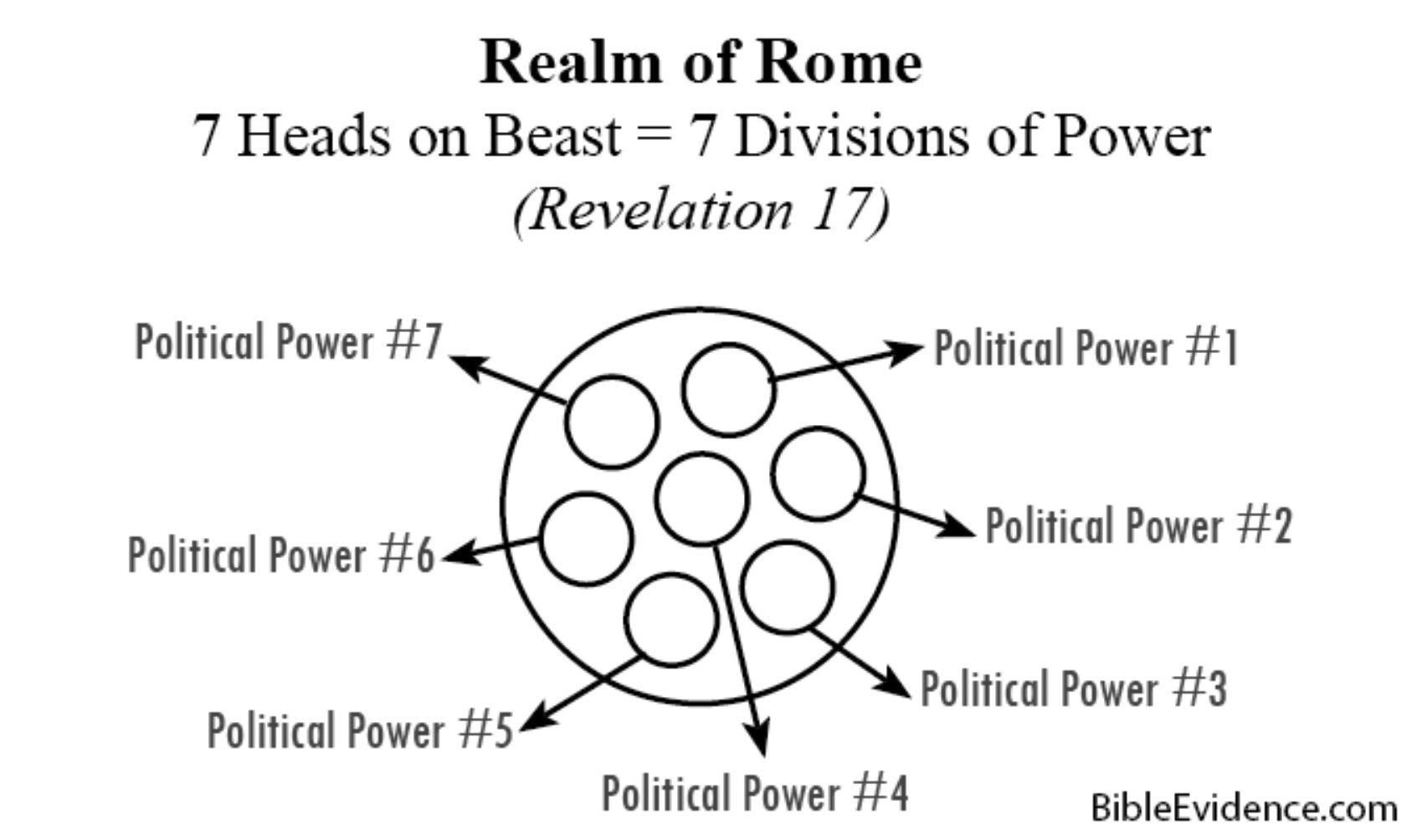
Guideline #5:
The heads on the Scarlet Beast = Successive political powers that arise from within the Roman realm.
The prophecy in Revelation 17 presents the 7 heads as consecutive powers instead of ruling simultaneously, by the phrase "five are fallen, one is, and one is yet to come". Thus, the heads would represent 7 divisions of power that arise successively within the Roman realm. This is not unusual, for the number 7 is used throughout Revelation to indicate successive time periods within a whole unit (7 Churches, 7 Seals, 7 Trumpets, 7 Thunders, 7 Last Plagues). This is similar to the week (whole unit), which contains 7 consecutive days (successive time periods).
In contrast to the successive, conquesting realms of Babylon, Medo-Persia, Greece and then Rome, the entities represented by the heads are already a part of a realm. They rise to power from within the Roman realm, perhaps "peacefully", for example through an agreement, or through political deceit or physical battle.

Guideline #6:
The 7 Trumpets cover the time period of the Christian Era.
Let's turn now to look at the 7 Trumpets. Before they sound, an overview scene is provided (Rev. 8:2-6), which focuses on intercession. The filling of the censer with incense and prayers indicate a beginning of a time of intercession as Christ begins His ministry after His resurrection and ascension to heaven. The filling of the censer with fire and throwing it down indicate an ending of intercession as Christ closes His ministry and returns to earth at His second coming. This introductory scene sets the stage (intercession and judgment) and time frame (Christian era) of the 7 Trumpets.
The time frame is also supported by studying the parallelism used by Daniel and John in their prophecies. Each of Daniel's prophecies cover the period of time from his day till the second coming. They each parallel the other, repeating the same basic structure, but adding additional detail relating to the prophecy's theme. Revelation uses the same method, developing parallel prophecies and covering the time from John's day (when Christ's ministry begins in 31 AD) till the second coming.
Additional evidence for this time frame are presented during Trumpet #7 of The 7 Trumpets.

Guideline #7:
The 7 Trumpets are judgments (plagues, wrath, calamities) on nations (the inhabitants of the land and its ruling entity) that result from a moral fall (persistant rejection of God and His messages).
The language and symbols used within the prophecy of the 7 Trumpets, reveal that it is focused on warnings and judgments. Throughout the Bible, it is shown that nations receive God's judgments after experiencing a moral fall (Jer. 48:21-47, Jer. 49:12-16, Is. 47:6, Jer. 8:7-13, Ez. 5:10-11). Only entities and rulers that practice righteousness avoid God's judgment and stay in power, though it can take a long time to reveal the truly rebellious and wicked state they are in. This is the case because "the throne is established by righteousness" (Proverbs 16:12), "righteousness exalteth a nation" (Proverbs 14:34) and "mercy and truth preserve the king" (Proverbs 20:28).
As previously outlined, a nation experiences a moral fall by persistently rejecting God and His laws. This rejection of God causes Him to withdraw His protection and send judgments, which allows disasters to ensue. Through it all, God sends warning messages to call individuals to repent and provide the faithful with instructions to escape the disasters. Eventually, after all have heard the warning, God allows the nation to more fully experience the results of its choices. There are great hardships and calamities, such as captivity, violent destruction of cities and loss of knowledge, etc. Ultimately, those ruling the nation lose their power and another ruling entity takes over.
During this time of judgment, the focus is on warning God's true followers so that they can escape to safety and avoid the destruction (plagues/wrath/vengeance) (Ez. 33:4, Luke 21:20-22, Rev. 18:4). The judgments affect ruling powers and the inhabitants of the land, who all have participated in rejecting the warnings (2 Kings 21:10-18). Eventually, after God has done everything He can to save as many people as will be saved, and the nation has descended into even worse crimes against God, the nation's fall is complete. This results in catastrophes and power being taken out of the hands of the ruling entity and given to someone else. God is in control of these events, and thus takes responsibility for placing and removing ruling entities from power (Dan. 2:36-38, Is. 14:24-25, Gen. 15:16, Hag. 2:22).
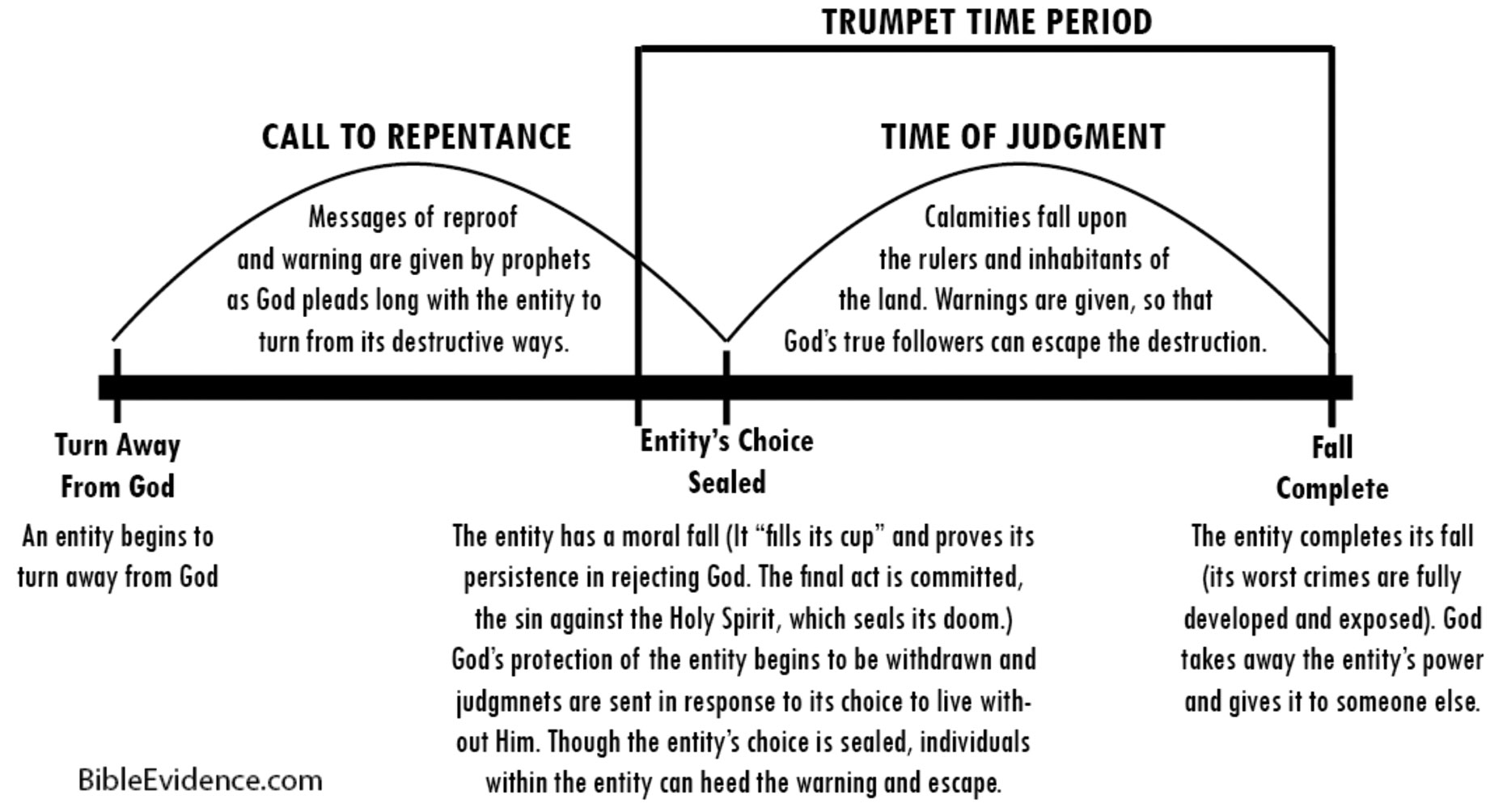
Guideline #8:
The 7 Trumpets represent 7 successive judgments upon ruling powers and their inhabitants who have control over God's people and reject the gospel message over 7 different periods of the Christian Era (with no gaps inbetween).
From a historicist perspective, the 7 Churches represent the spiritual condition of God's church over 7 different periods of the Christian Era. The time periods are sequential with no gaps between the time periods. Similiarly, the 7 Spirits (Rev. 4:5, 3:1) are not 7 different spirits, but rather represent the work of the Holy Spirit within those 7 Churches during those same 7 time periods. Again, there are no gaps between the periods, which makes sense because there is no time when the Holy Spirit isn't at work in the churches. In like manner, the 7 Seals represent the conditions (persecution, leadership compromise, spiritual darkness, signs in nature) developing as God's people spread the gospel message over 7 different periods of the Christian era. The manner in which the 7 Seals are given also confirm its time periods are sequential. It would be sensible that the 7 trumpets would follow the same pattern of revealing characteristics of 7 different periods of the Christian Era, occurring one right after another with no gaps in between. They would also continue the developing Revelation story by focusing on those who reject the gospel message and have control over God's people during those same periods.
That the Trumpets cover consecutive periods, without any gaps inbetween them, follows the same pattern established in other prophecies. In addition, the 5th and 6th Trumpets actually provide specific time frames for their sounding, setting a precedence for the other Trumpets to also describe characteristics of large periods of time and not just singular or short-term events.

Guideline #9:
Parallel prophecies are common in the Bible and we should look for the same to occur with the 7 trumpets.
Prophecies throughout Daniel and Revelation parallel each other. For example, Daniel symbolizes the realm of Greece in four different parallel prophecies (see chart below), first as the thighs of brass on Nebuchadnezzar's image, then the 4-headed leopard (leopard-like beast), then the goat with the notable horn that breaks into 4 pieces, and finally the realm of Greece divided toward 4 winds (Daniel 11). Each prophecy provides different details, expanding and clarifying on the theme and entities.
Seeing the same entity represented by different symbols in different prophecies, and seeing the same time frame repeated in different prophecies is common. For the 7 Trumpets to be isolated from this parallelism would be unusual. Linking the 7 Trumpets to the same timeframes and entities that occur in other prophecies, such as the 7 Heads, is a Biblical method, which seems well-designed to help us identify meanings and verify interpretations.
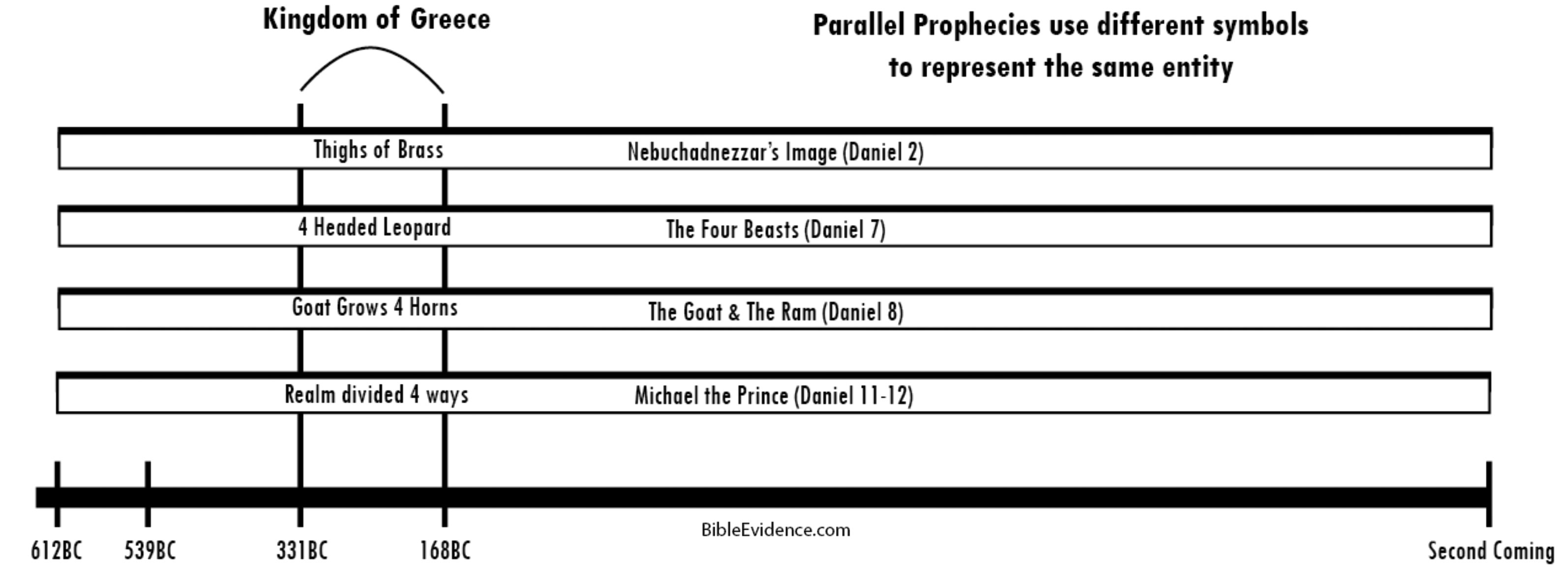
Guideline #10:
Since the 7 Trumpets outline seven judgments on ruling powers and their inhabitants, the Trumpets are tied to the prophecy in Rev. 17 that identifies the seven ruling powers.
The political powers brought forth in Bible prophecies are those that are most involved with the experiences of God's people. The seven judgments outlined in the 7 Trumpets are upon those responsible for rejecting the gospel message and persecuting God's people, namely those with political power over God's people. Since the seven judgments are tied to seven ruling powers, we are therefore tied to the 7 Heads that represent the seven ruling powers over God's people during the same time period. The political powers ruling during the Christian Era are the heads on the scarlet beast, which are the political powers who successively rule within the Roman realm. Thus, the 7 Trumpets and 7 Heads would correspond to the same time periods. For example, the 1st Trumpet would be a judgment upon the 1st head of the beast, the 2nd Trumpet upon the 2nd head, etc.
- Trumpet #1 = Warning and judgment against the first political power and its inhabitants within the Roman realm.
- Trumpet #2 = Warning and judgment against the second political power and its inhabitants within the Roman realm.
- Etc.
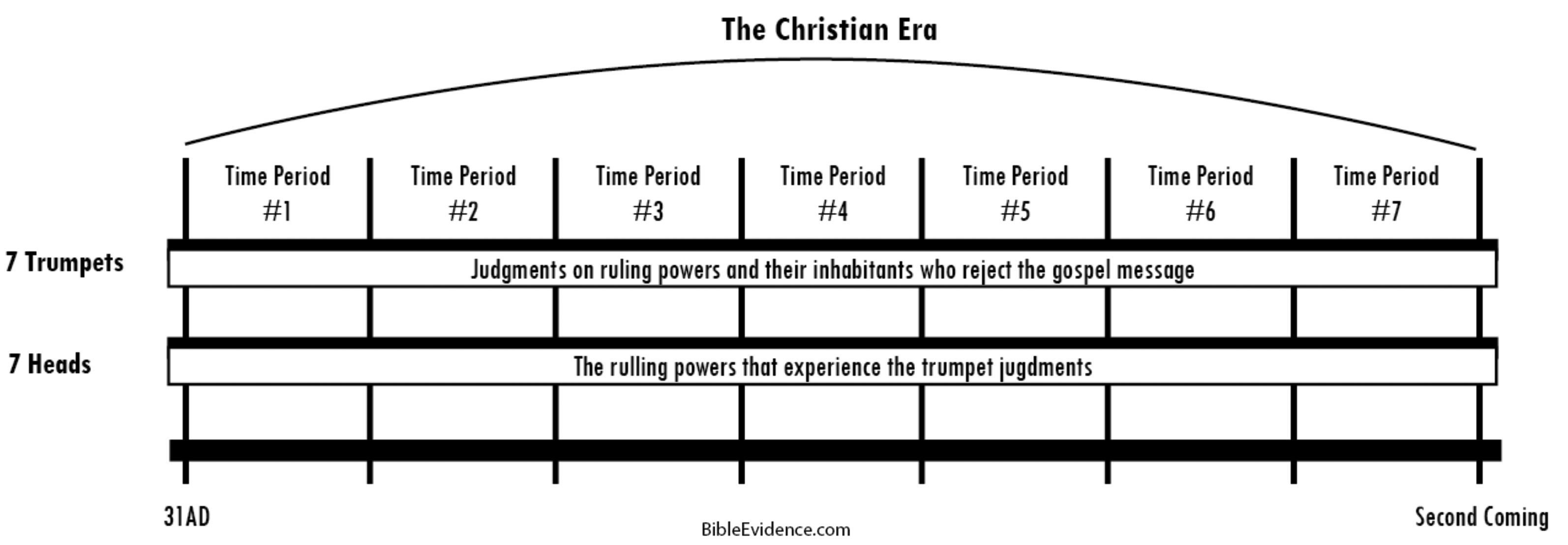
Guideline #11:
Since the 7 Heads experience a moral fall, which requires judgment, the heads are tied to the prophecy of the 7 Trumpets which outline the seven judgments.
In Revelation 17, five of the heads on the beast are described as "fallen" (Rev. 17:10). Babylon is also described as fallen (Rev. 14), which later culminates in a complete fall (Rev. 18) and its associated culmination of judgment and destruction (7 last plagues). When the Bible tells of judgment being executed, or an entity losing power, it is the result of a moral fall. The fall of the heads, would also be the result of moral falls. Here again, the falls and accompanying judgments of the heads, therefore tie the trumpets (judgments) and the heads (the ruling entities that experience the moral falls and resulting loss of power) together. One is needed in order to interpret the other.
Guideline #12:
During the time period of a Trumpet, the corresponding political power is the dominant influence in the realm, until God gives the crown to someone else.
Since the heads on the beast are successive, any corresponding judgments (Trumpets) would also be successive. The time period of an individual head and its corresponding Trumpet represent the time period that the political power has the dominant political influence over God's people. The land where the large portion of God's visible church have dwelt since Christ's day is in the Roman realm (note that this is now the nations within decentralized Rome, including the expanded territory of those nations). The time period encompasses the peak of the political entity's power. (Note that the entity may get quite weak by the time God places a new entity in power, but since they are still in power, they are considered the dominant power.) The political power may exist before and after the Trumpet is sounding, because powers take time to rise and decline, but during the trumpet's blast the entity is the dominant influence. This is because God has given the entity power over His people when He took power from the previous entity. Thus it is responsible for the actions it causes against God's people and its leadership in rejecting the gospel message.
The time of judgment comes in the form of spiritual disasters and/or physical destruction as God withdraws His protection and gives them over to other forces, such as an invading army (e.g. Egypt given over to Babylon, Babylon given over to Cyrus' army). The decline in an entity's power begins before they lose dominance, and the entity may or may not still exert some degree of political power after that Trumpet ends. The end of a political power's dominance marks the point when God gives the crown to someone else. The end of the power altogether, may come about quickly, or not occur for hundreds of years after they lose their dominance.
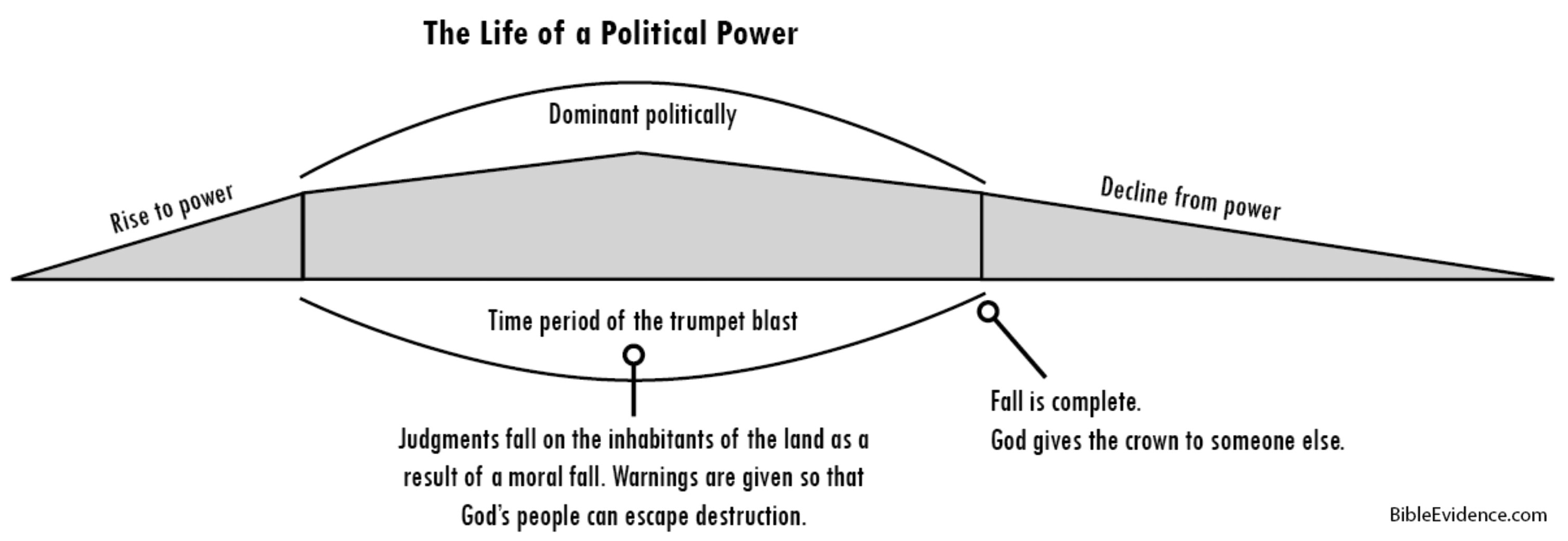
Guideline #13:
A dominant power is responsible for overthrowing the previous dominant power. A dominant power is overthrown by the next dominant power.
A new political entity that rises into power, displaces the previous one, by its force of power or influence (e.g. Medo-Persia is responsible for overthrowing the Babylon realm and becomes the next dominant realm, and then Greece is responsible for overthrowing Medo-Persia and becomes the next dominant realm, etc). It is common in Bible stories for God to allow one power to displace another power and refer to it as a judgment (Ez. 30:10-19).
When God spoke through Ezekiel, He told of how Israel's crown was given to Babylon and the Israelites were taken captive because of their sins. But, He also said that Babylon would enventually be overturned, and so on, until the crown would finally be given to Christ and sin would end.
"The word of the LORD came unto me again, saying, Also, thou son of man, appoint thee two ways, that the sword of the king of Babylon may come: both twain shall come forth out of one land: and choose thou a place, choose it at the head of the way to the city... Therefore thus saith the Lord GOD; Because ye have made your iniquity to be remembered, in that your transgressions are discovered, so that in all your doings your sins do appear; because, I say, that ye are come to remembrance, ye shall be taken with the hand. And thou, profane wicked prince of Israel, whose day is come, when iniquity shall have an end, Thus saith the Lord GOD; Remove the diadem, and take off the crown: this shall not be the same: exalt him that is low, and abase him that is high. I will overturn [Medo-Persia overthrows Babylon], overturn [Greece overthrows Medo-Persia], overturn [Rome overthrows Greece], it: and it [Judah's kingship] shall be no more, until he come whose right it is; and I will give it him [Christ's eternal realm]." (Ezekiel 21:18-19, 24-27 KJV).
There is an unbroken succession of power as the crown is passed from one entity to the next. This is the same with the political entities (heads) within the Roman realm (beast). There is an unbroken succession of power, as only one entity can be politically dominant at a time. Thus, if a particular political power is identified, the power before and after it can be identified by determining who it overthrows and who overthrows it. This guideline will be very clearly illustrated as we study the history of these political entities.

Guideline #14:
A dominant political power within the divided Roman realm has multinational influence.
A dominant political power is not necessarily directly in charge of the biggest or most powerful nation(s). But, it has extensive influence and exerts political control over those nations. In fact, especially as the Roman Empire divided into separate nations, we would expect successful political powers to be unconstricted by borders and active in multiple nations. An example of this is the papacy. It was not necessarily a mighty nation in and of itself, but it had power to convince many other nations to obey it. In addition, since these political powers rise from within the same realm (Rome), we wouldn't necessarily expect to always see violent battles for power, but more of a political positioning or out-maneuvering. Some shifts in power might even be seen as a welcome and necessary reponse to a catastrophe or changing world and the needs of the citizens.
Guideline #15:
Being a dominant political power means sitting on, determining who sits on, or legitimizing who sits on the seat(s) of power.
In order for a political entity to be considered dominant, it needs to establish control of the crown in the most powerful nations of the Roman realm. This means it would have the power to determine or ruin emperors and government leaders. It would also have a strong cultural and economic influence over the region. The date power shifts from one entity to the next, and therefore the start of a new Trumpet time period, can be identified by determining when the political entity gained the power to establish who sits on the seat(s) of power. This can mean that someone within the entity itself sits on the throne, or that it chooses or legitimizes who does sit on the throne. Note that a political entity can be seen as quite weak by the end of its reign, but it is still in the power position until the next entity takes over. Identifying the seat(s) of power in the realm is accomplished by determing the location of the mightiest nations in which the large part of God's people dwell.
Being the dominant political power or "emperor chooser", doesn't mean that the political entity is in control of all events. On the contrary, many of these political entities are often supressed and undermined by the emperors themselves. It seems as though the struggle for power and in-fighting are constantly manifested throughout the history of the Roman realm. The power that legitimizes the ruler and the ruler himself often have a troubled relationship of constantly attempting to subjugate the other.
Guideline #16:
The time period of a political power's dominance is characterized by the events described in the corresponding trumpet.
The Trumpets include descriptions of judgments that affect the inhabitants of the land of the ruling political entity. Remember that God's judgments are not haphazardly given, but fair and affect an identifiable entity or group of people. The time period that one political entity is dominant is characterized by one Trumpet judgment. This includes any time prophecies given in the trumpet. For example, in the 6th Trumpet, a period of time for the judgment to occur is defined. The time period would then also designate the length of time the entity is dominant.
Guideline #17:
Since nations bring judgments upon themselves, there will be evidence that the calamities described in the Trumpets will be caused or allowed to occur by the nations themselves.
The actions of a ruling power in rejecting God's laws bring about the conditions described in the Trumpet. There is a cause and effect action. Thus, the descriptions of a Trumpet provide insight into the political environment of the time period and the events with which ruling entities are primarily dealing.
Guideline #18:
Prophetic symbols should be interpreted consistently and from the Bible itself.
Interpreting symbols used in the 7 Trumpets should be done in the same way as the rest of prophecy; let scripture interpret itself. Plus, if a prophecy is given in symbolic language, like the 7 Trumpets are, then symbols should be interpreted consistently across different prophecies as context permits. For example, the 4th Trumpet describes the sun, moon and stars being darkened. In Rev. 1:20, stars are explained to symbolize the messengers of God's churches. So, the beginning of a simple interpretation of the 4th Trumpet would indicate a time period where God's messages are darkened or obscured as God's true messengers are restricted from preaching.
Summary
The guidelines for linking the 7 Trumpets to the 7 Heads of Revelation are summarized as follows:- The beast of Revelation symbolizes the Roman realm and its 7 heads symbolize 7 successive political powers within the Roman realm (a beast = a single realm).
- The 7 Trumpets are judgments (afflictions, plagues, calamities) on nations who reject the gospel message and have control over God's people (the inhabitants of the Roman realm and its ruling political powers) during 7 successive time periods (with no gaps inbetween) stretching from Christ's day until the second coming.
- Judgments occur as a result of a moral fall by a nation and its ruling political powers. The Heads reveal the identity of those political powers. The Heads on the beast are said to have "fallen" (Rev. 17:10), which includes a moral fall and accompanying judgment. The Trumpets reveal those judgments. Thus, the 1st Trumpet coincides with the reign (politically dominant phase) of the 1st head on the beast, the 2nd Trumpet coincides with the reign of the 2nd head on the beast, etc. This places these two prophecies on parallel timelines, which is a common occurence in the Bible as later prophecies parallel and expand upon the first.
- During the time period of a Trumpet, the corresponding political power (Head) has a multinational and dominant influence in the realm. This means sitting on, determining who sits on, or legitimizing who sits on the seat(s) of power. A dominant power is responsible for overthrowing the previous dominant power and a dominant power is overthrown by the next dominant power. We can then expect a shift in dominant power as each Trumpet transitions, and we will look for this exact correlation in history.
- The time period of a political power's dominance is characterized by the events described in the corresponding Trumpet. Since nations bring judgments upon themselves, the conditions of the Trumpet can be linked to the actions (or inaction) of the ruling power. This relationship between nations rejecting God and the resulting judgment is not vague or distant, but an intimate connection of Biblically guaranteed cause and effect.
- When unlocking prophetic symbols they should be interpreted consistently and from the Bible itself. The meanings should become ever clearer as we get closer to the second coming. Christ's love and long-suffering will be seen during each stage of history and He will be proven right and just in all His judgments.
Political Entity Identification Questions
- Does the political entity sit on, determine who sits on, or legitimize who sits on the seat(s) of power (primarily the emperor, but also kings, senators, governors, generals, judges, etc)?
- Does the political entity rise from within the Roman realm?
- Does the political entity become the most dominant political influence in the realm?
- Did the political entity displace the previous dominant force?
- Does the political entity get displaced by the next dominant force?
- Does the political entity rule, and the Trumpet judgment affect, the location where God's church is located?
- Is the time period of the entity's dominance, characterized by the conditions symbolized in the Trumpet?
- Does the political entity's own actions bring the Trumpet judgment upon itself?
